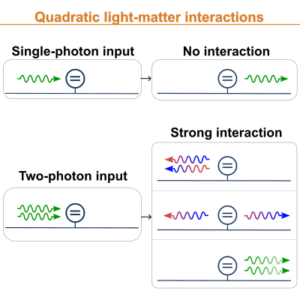Waveguide QED with Quadratic Light-Matter Interactions – PRX Quantum
ISC researcher S. Felicetti is the lead author of a research article now published in PRX Quantum, in collaboration with Aalto University (Helsinki) and the Institute of Fundamental Physics IFF-CSIC (Madrid): U. Alushi, T. Ramos, J.-J. G.-Ripoll, R. Di Candia, and S. Felicetti PRX Quantum 4, 030326 (2023).

A theoretical study of quantum emitters quadratically coupled to propagating modes overcomes intrinsic limitations of current waveguide-QED settings, including a no-go theorem on the CPHASE gate.
Quadratic light-matter interactions are nonlinear couplings such that quantum emitters interact with photonic or phononic modes exclusively via the exchange of excitation pairs. Implementable with atomic and solid-state systems, these couplings lead to a plethora of phenomena that have been characterized in the context of cavity QED, where quantum emitters interact with localized bosonic modes. Here, we explore quadratic interactions in a waveguide QED setting, where quantum emitters interact with propagating fields confined in a one-dimensional environment. We develop a general scattering theory under the Markov approximation and discuss paradigmatic examples for spontaneous emission and scattering of biphoton states. Our analytical and semianalytical results unveil fundamental differences with respect to conventional waveguide QED systems, such as the spontaneous emission of frequency-entangled photon pairs or the full transparency of the emitter to single-photon inputs. This unlocks new opportunities in quantum information processing with propagating photons. As a striking example, we show that a single quadratically coupled emitter can implement a two-photon logic gate with unit fidelity, circumventing a no-go theorem derived for conventional waveguide-QED interactions.


